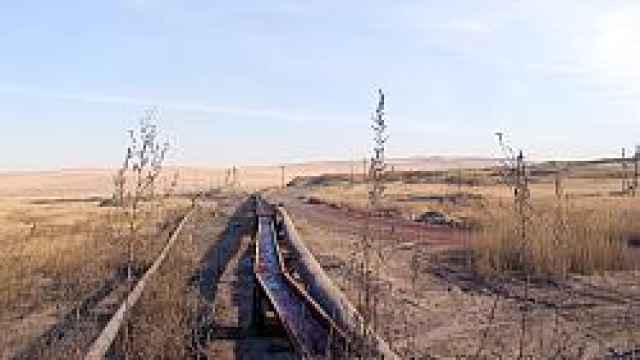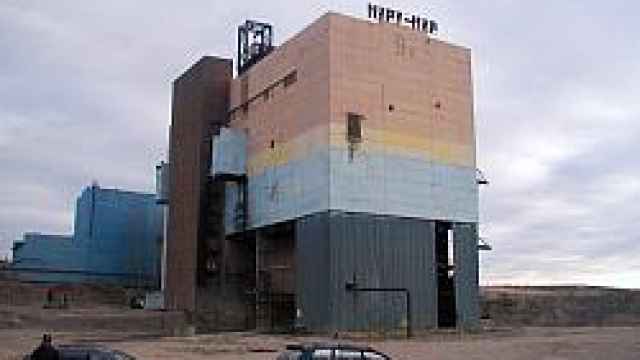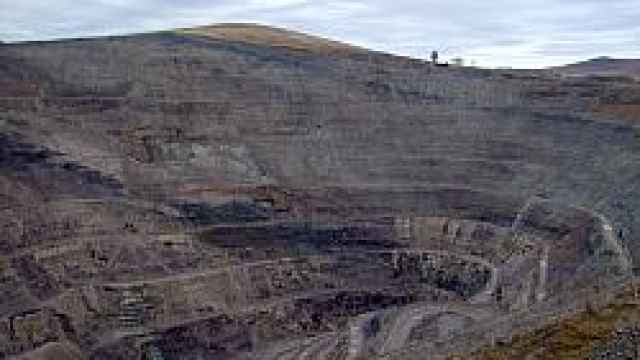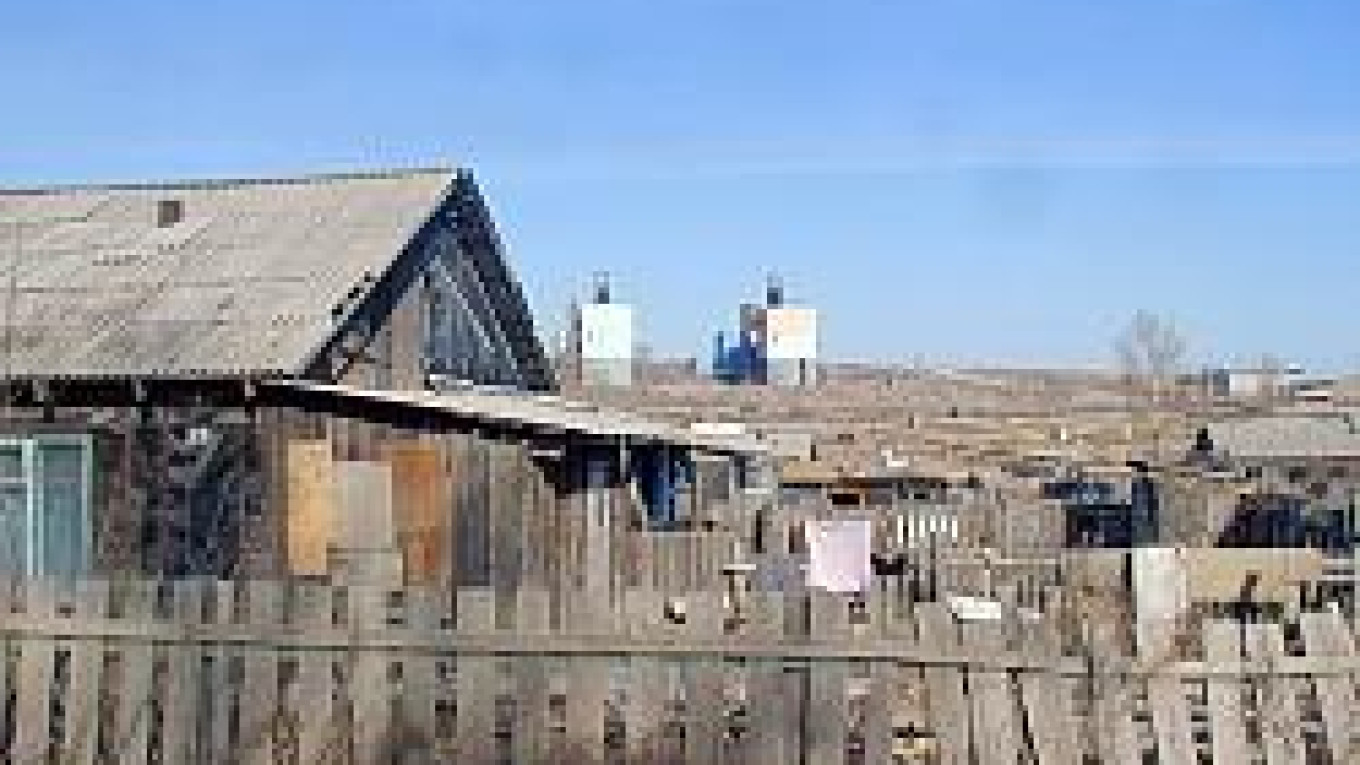The geologist's tightly crammed bookcases also hold another legacy of his discovery: thick reports that plot radioactive pollution zones, heavy metal deposits and acid rain.
Outside his window lies the village of Oktyabrskoye, a ramshackle collection of wooden huts and potholed roads surrounded by mine shafts and dilapidated uranium-processing facilities barely 2 kilometers away. This is Filipchenko's home.
Once it was a prestigious place to sit. Built in 1964 as the first outpost in the Soviet government's drive for uranium on Russian soil, the geologists' village led to the founding of an entire city, Krasnokamensk, and a uranium mine that became the biggest in the world.
Now, the village, located in the east of Siberia just 60 kilometers from the border with China, lies disastrously neglected and poisoned by uranium dust and radioactive gases.
"This is a man-made disaster area," Filipchenko said, unfurling a map showing radiation and pollution levels from a nearby power station and uranium enrichment plant.
Uncovered mountains of discarded uranium ore dot the surrounding horizon, while just over the hill, a vast open crater marks the site of Russia's first uranium mine. Drive along the unguarded roads to the processing plant and there's the sprawl of an industrial site falling apart. Cast-aside pipes and broken windows loom.
The neglect is not just an environmental disaster. A lack of investment is also spelling catastrophe for the nation's nuclear industry, experts say. The Krasnokamensk mine that Filipchenko helped to find is the sole uranium producer of any significance on Russian territory and it produces enough ore to supply half the needs of Russia's nuclear power plants. Without investment, the mine -- and Russia -- will run out of ore.
"Krasnokamensk is of huge strategic importance. If it goes, then Russia loses 50 percent of its supply," said Vladimir Chuprov, the head of the energy division at the Moscow office of Greenpeace, who has closely investigated the nation's nuclear industry.
The state of Krasnokamensk, once the object of all the money the Soviet government could throw at it, is typical of Russia's transformation to capitalism. But in this case, it's not the much-vilified private business barons that have let this place go to seed. The Krasnokamensk mine and the plant that processes the ore into concentrated uranium ore, or yellowcake, are owned by a state nuclear agency, TVEL.
"As soon as we get the uranium in canisters, it becomes the property of TVEL," said an official from the Priargunsky kombinat, or combine, which runs the mine, the processing plant and other attached facilities. "All the rest of the nuclear cycle is run by TVEL, and they keep the money. Here the equipment is worn out, the wages are low for the people who take all the risks, and we need a new mine.
|
TVEL, which has its headquarters in Moscow, is run by Alexander Nyago, a former telecommunications executive from St. Petersburg who is close to President Vladimir Putin. Last year, as world uranium prices climbed, the agency, which owns other processing plants and sells fuel rods for nuclear power stations in Russia and abroad, racked up official profits of $164 million. With world yellowcake prices doubling over the last year to $33 per pound, this year it's expected to make even more.
Officials at the Krasnokamensk combine, however, say they have virtually no profit left to play with. Most of the cash they have goes toward paying taxes and wages for the combine's 12,500 workers, they say. Officially, the average wage is 10,000 rubles (about $300), low for an industry where the health risks are high.
Living on Borrowed Time
Nuclear industry experts say senior managers at state-owned TVEL differ little from the oligarchs pilloried for sucking profits out of extraction industries and stashing them in accounts elsewhere.
It's no small irony that Mikhail Khodorkovsky, one of the most vilified oligarchs of them all, was sent to serve out the remainder of his eight-year prison sentence in the Krasnokamensk prison camp nearby. The former Yukos oil owner was convicted of fraud and tax evasion in a case seen by many Russians as seeking to right the wrongs of more than a decade of capitalist pillaging and infrastructure neglect.
But some say the state should try to right those wrongs by sorting out its own industries first.
"There has to be state support if the government does not want the uranium industry to die out," said Gennady Pshakin, an expert on the nuclear industry who heads a nonproliferation analytical center in the nuclear reactor town of Obninsk, just outside Moscow.
Russia's nuclear industry is already living on borrowed time, said Pshakin, who has served for more than seven years as a nuclear inspector for the International Atomic Energy Agency. TVEL is "living off old stores," he said.
Without investment to build a new mine, the combine at Krasnokamensk will run out of ore in 2012, the combine official said. Currently, it produces 3,000 tons of uranium per year, almost half the amount needed to supply Russia's nuclear power stations, said the combine official and Maxim Shingaryov, who heads the information center for the Federal Atomic Energy Agency, or Rosatom.
Overall, Russia needs about 15,000 tons per year to run its power stations, fuel its nuclear submarines and meet its export agreements, according to researchers at the Natural Resource Ministry. Part of the rest comes from recycling fuel and uranium ore imports.
Mainly, however, the shortfall is made up from stockpiles of uranium built up during the nuclear spending frenzy of Soviet times. But these stockpiles are being sold off so quickly they could run out as soon as 2010, a report by the ministry's researchers said.
Even though the condition of Russia's nuclear stockpiles has largely been considered a state secret, researchers from Urangeologorazvedka and the All-Russia Scientific Research Institute of Mineral Resources, or VIMS -- both research centers of the Natural Resources Ministry -- produced a report on the issue that was published as part of an international conference on the nuclear industry held last year in Tomsk. It said Russia's stockpiles could run out as soon as 2010.
"Russia will be hit with a uranium crisis a lot earlier than 2020. In the next seven to eight years it will turn from an exporter of natural uranium into an importer of it," said the 2004 report, a copy of which was obtained by The Moscow Times.
If true, that could have huge consequences for world uranium markets. World uranium prices have been climbing partly because of a lack of information about Russia's stockpiles, and because consumption worldwide is almost twice as high as production. Most of the shortfall is made up from supplies from Russian stockpiles and from recycling waste.
An agreement Russia has with the United States under the Megatons to Megawatts project, in which high-grade uranium from dismantled nuclear warheads is converted into low-grade fuel, supplies enough fuel to produce 10 percent of the electricity consumed in the United States each year. That agreement, however, is due to expire in 2013.
The United States wants Russia to sign off on a follow-up agreement to convert more megatons to megawatts once that contract expires, but the Russian government has been stalling, said Rose Gottemoeller, a former deputy secretary for defense nuclear nonproliferation in the Energy Department under the Clinton administration. "From the perspective of the U.S., Russia still has plenty of supplies and should continue the deal," said Gottemoeller, who is now a senior associate at the Carnegie Endowment for International Peace.
Russian concerns that its reserves are running out may be one reason the government has not been eager to extend the agreement, she said. "They've never given a formal reason, but that's one speculation," Gottemoeller said.
Like many other countries, Russia has been stepping up its research into the development of a new generation of fast reactors that can efficiently burn plutonium because of fears over a reserve crunch, she said.
Others, however, say Russia's stockpiles will last for much longer. If uranium prices remain high, it will be profitable to invest in extraction and into enriching tailings left over from processing fuel, said Rosatom's Shingaryov. "The enriched uranium tailings could last for several dozen more years."
 Catherine Belton / MT Pipes leading from the processing plant carry acid byproducts to a storage site. The head of the town's ecological committee fears the waste could overflow. | |
For much of the last decade, uranium prices had been so low that it made no commercial sense to invest in the mining industry, Shingaryov said. As recently as 2000, world uranium prices were at a low of $7 per pound.
As the squeeze in supplies has sent prices soaring to $33, combine officials in Krasnokamensk complain that they have not been seeing any of the profits. Last month, the head of the combine, Valery Golovin, traveled to Moscow to ask TVEL to redraw its sales contracts and raise the price it pays for the Krasnokamensk yellowcake.
The town's mayor, and a previous general director of the combine, German Kolov, is hoping for the same. "Ever since 2000, TVEL has raised wages at the kombinat a little every year. But in my opinion, it really has not been enough. If they're compared with wages at other TVEL-owned enterprises, then ours, in the farthest corner of Siberia, are two times lower," Kolov said.
Combine officials said they are still waiting for a decision from TVEL.
In written answers to e-mailed questions, TVEL vice president Stanislav Golovinsky sidestepped the question of whether TVEL would raise the price it pays for yellowcake in line with world prices to allow wage hikes at the plant. Instead, he replied that the average wage at the combine was no lower than it was at other TVEL-owned enterprises. He did say that TVEL was planning major new investments in Krasnokamensk, but gave no timetable.
For the workers, everything depends on the decision TVEL makes.
"The uranium mine is completely dependent on the leadership of TVEL, on whether they want to invest money," Pshakin said, adding that so far TVEL has shown little interest in putting up cash either to improve the lives of the workers or to invest in the mine. He predicted this was unlikely to change.
"They want to make money immediately and as much as possible. And then the money goes toward the upkeep of their own apparatus," he said. "As long as they can keep Krasnokamensk going on the cheap, they will continue to take uranium from there. But they will make few investments there as this requires long-term funds."
Greenpeace's Chuprov said it was a typical situation in Russia for the extracting sector to be loss-making. "They have very low wages and no investment. All the profit is concentrated in TVEL," he said. "Their behavior is the same as the oligarchs."
Golovinsky, however, said plans had been drawn up for building a new plant to produce sulphuric acid, one of the vital raw materials used in turning the uranium ore into yellowcake. The construction of a new mine would require an investment of billions of rubles, and TVEL already had a business plan, he said in the e-mail exchange, conducted via TVEL's press office.
Neither he nor TVEL president Nyago was available for an interview until the new year, the TVEL press office said.
Golovinsky did not say when the investment project would begin and also added that TVEL would need help from the state to get it off the ground. Unlike the researchers from the Natural Resources Ministry, he gave no sense of urgency, estimating that the existing mines at Krasnokamensk have enough ore to last for 15 to 20 years.
Even if Golovinsky's estimates prove accurate, TVEL may still be too late. According to the researchers' report, it takes 15 to 20 years to develop and start up a new uranium mine.
 Catherine Belton / MT The sign "Peace to the World" sits atop one mine shaft outside the village. | |
Back in Soviet times, money wasn't an issue. Soviet governments threw all the rubles the printing presses could muster at the nuclear industry. They built mines and processing plants in Kazakhstan, Uzbekistan and, after World War II, in Warsaw Pact countries Czechoslovakia and Bulgaria.
When Filipchenko made his find in Krasnokamensk, the government dispatched town planners from Moscow and St. Petersburg to build a state-of-the art company town. In Soviet days, Krasnokamensk, which was a closed city, won prizes for the cleanliness of its streets and its tight-knit social infrastructure. A labor camp, meanwhile, was established nearby, and its inmates were used to mix cement for the building of the mine and town where before there was nothing but bare steppe.
"Until now, no one has ever asked what the Soviet government spent on creating our nuclear industry. This is a history covered in a dark, gloomy secret," Pshakin said. "They gave out money without making any accounts. That was a time when we needed to have a nuclear force, no matter what. They just didn't count how much they were spending."
Now, after policies like these ended up helping to bankrupt the Soviet Union, the state is besieged with a multitude of other problems that are competing with the nuclear industry for a share of the cash. "There are always other priorities. There's always something that doesn't have enough money. The list is endless: pensions, the military, the aircraft industry, the missile industry. They're all suffering," Pshakin said.
But whether or not any cash is disbursed to keep Krasnokamensk's industry going, it has been left with a dangerous legacy from the Cold War buildup that urgently needs attention, environmentalists and residents say.
 Catherine Belton / MT The uranium processing plant is about 2 kilometers from the Oktyabrskoye village. It can be visited only with special permission from TVEL, the Moscow-based nuclear fuel trading agency. | |
The last time anyone conducted a major environmental study was in the early 1990s when Filipchenko and other scientists, including a group of doctors from the state university in Irkutsk, spent months mapping levels of pollution from the mine, the plant and the nearby power station, which is fired with uranium-contaminated coal.
Filipchenko still keeps the results of those studies in thickly bound books and large maps, which he readily opens for anyone interested. But after some of the results of his study were smuggled to scientists in Sweden and shared with a group of Greenpeace activists, who used the data as part of a widely publicized report in 1994 on the dangerous state of Krasnokamensk, scientific investigation was stopped.
"No one has denied this data, but no one risks repeating the experiment," Filipchenko said.
What Filipchenko and his colleagues found were dangerously high levels of radon gas emanating from the cellars of scores of houses in the Oktyabrskoye village, mounting levels of uranium dust, measured in winter dissolved in the snow, as well as heavy metals such as mercury.
The village, which sits in the middle of an industrial zone and on top of a mine, is an ecological catastrophe, Filipchenko said. "The village should not be in this place. It has to be moved," he said. "The entire village is in a zone of acid pollution."
After the environmental studies found their way into the hands of the Greenpeace activists, federal officials in Moscow took note of the village's plight and began disbursing funds to resettle the residents. But the money sent in the mid-1990s was obliterated in the 1998 financial crisis, and since then the funding has not been enough. So far, 240 families have been resettled in Krasnokamensk, a town of 61,000 people, but 680 families remain in the village.
Matters appear to be better for the town, some 20 kilometers away from the mine, where levels of radiation and other elements were found to be no higher than average. But, Filipchenko said, the combined affects of radiation and these other elements have never been studied. "For each element, the content is lower than permitted levels. But if you put it all together, no one knows the combined effect. It has not been studied," he said. Plus, he said, because the last study was more than 10 years ago, no one knows what the situation is now.
The head of the town's ecological committee, Yevgeny Bakulenko, said one fear was that storage sites for liquid acid waste from the processing plant could overflow and seep into the surrounding soil.
For the village, the dangers are clear. When Oktyabrskoye was built back in 1964, it was never intended as a permanent fixture. It was built as temporary housing for the first group of geologists who arrived here and discovered the deposits, which is why it was located so close to the mines. To make matters worse, when more deposits were found under the village itself, the government decided to go ahead and mine anyway.
As a result, radon gas seeps through cracks in the soil and into houses. In some houses, where owners dug underground cellars for storing produce, the levels measured were more than 100 times the norm. Exposure to high doses of radon can cause lung cancer.
Those who remain in the village have become so inured to their surroundings that they gather scraps of uranium ore from the heaps beside the mines to fill the potholes in the village roads. "They just take it and sprinkle it outside their own homes," Filipchenko said with a grim chuckle. "This is a problem for radiation levels. ... But at least it can be solved."
Gathered outside one of the rundown village shops, a group of residents say they regularly try to push their case for resettlement in the offices of the Krasnokamensk administration, so far to no avail. There's simply not enough cash to go around. But they are desperate for new homes.
"We live in the middle of an industrial zone. No one should be living here," said Yekaterina Zimniyeva, a former mine worker who helped build the mines in the late 1960s and still lives in the village.
"Here, we eat uranium, we drink uranium, we breath uranium," she said, as she towed along her young grandson, who, she said, was constantly suffering chest colds. "Everyone's legs here hurt terribly. People suffer heart problems, and there isn't anything to breathe," she said. "It's OK for us. We're old already. But these little ones have to grow up here. The wind blows everything here. There's nothing to breathe."
Tight-lipped town doctors insist health problems -- in the village as well as in the town -- are no worse than average.
"Radiation levels are no higher than they are across the entire Siberian Federal District," said Viktor Turanov, a surgeon in the oncological wing of regional hospital No. 4. "And the level of cancer is no higher than the average across all of Russia."
Instead, he blamed the villagers' woes on poverty and unhealthy lifestyles. "Their legs would hurt less if they stopped smoking and started drinking less," he said.
 Catherine Belton / MT A vast crater marks the site of Russia's first uranium mine. After deposits were discovered in the 1960s, the mine grew to become the largest in the world. | |
But town officials, like town doctors, insist that the health risks of living and working here are minimal. "The population of the town is stable," said Krasnokamensk Mayor Kolov. "We aren't losing people. This is a subject of special pride. While in Russia this is a huge problem, here the number of births is higher than the number of deaths."
There's little way of determining who is right since there are no studies available. Kolov recently ordered his health officials to produce a report breaking down the causes of death in the Krasnokamensk region, but it was unclear when it would be ready and whether it would be publicly available.
In the meantime, the mayor said he was hoping that the attention the town has received ever since Khodorkovsky's arrival at the nearby prison camp will help him in his efforts to win more government funding for the resettlement of the Oktyabrskoye villagers.
Greenpeace's Chuprov, however, said he feared the politically charged presence of the former oil tycoon could make it even harder to carry out environmental studies.
"There's been no analysis since the last Greenpeace study in 1994. We need to know how much dust is in the area. There needs to be an independent investigation," he said. "But it's not clear if the authorities are ready to allow this, especially now. If anyone dares to do this, it is likely they'll find themselves in the cell next door to Khodorkovsky."
A Message from The Moscow Times:
Dear readers,
We are facing unprecedented challenges. Russia's Prosecutor General's Office has designated The Moscow Times as an "undesirable" organization, criminalizing our work and putting our staff at risk of prosecution. This follows our earlier unjust labeling as a "foreign agent."
These actions are direct attempts to silence independent journalism in Russia. The authorities claim our work "discredits the decisions of the Russian leadership." We see things differently: we strive to provide accurate, unbiased reporting on Russia.
We, the journalists of The Moscow Times, refuse to be silenced. But to continue our work, we need your help.
Your support, no matter how small, makes a world of difference. If you can, please support us monthly starting from just $2. It's quick to set up, and every contribution makes a significant impact.
By supporting The Moscow Times, you're defending open, independent journalism in the face of repression. Thank you for standing with us.
Remind me later.


